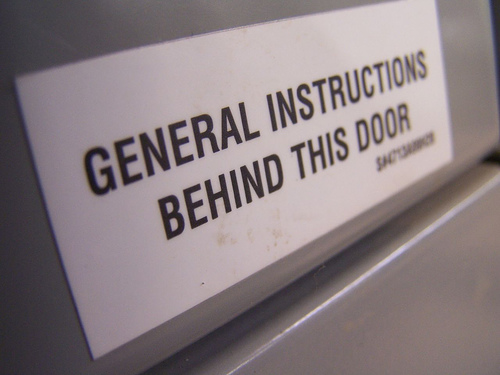
Save Time With An SOP
Wednesdays are simplicity days at SimpleProductivity blog.
I want you to think of something that you don’t do very often but are rather complicated. Did you have to spend extra time trying to remember all of the things you needed to do? Or did you forget something and have to go back and do it? That’s where an SOP can help.
Standard Operating Procedures
A Standard Operating Procedure, or SOP, is a set of repeatable instructions. The goal is to have a document that someone else can pick up and do a function. It’s a fancy way of saying “instruction manual”.
How SOPs Are Used In Business
Many businesses, particularly manufacturing, use SOPs to make sure that things are done consistently. You might have SOPs for everything ranging to QA chemical tests to changing the toner in the copier to requesting a purchase order for office supplies.
SOPs are put into place to make sure that people who don’t quite know the job can do the job without missing any steps.
How SOPs Can Be Used In Life
SOPs do not apply just to business, though. They can be used as a guideline any time you have to do something complicated that you also do infrequently.
One of my prime examples is processing the Girl Scout training files. Every month I get two spreadsheets…one with the training data for my service unit, the other with the list of current volunteers in the service unit. Neither one of these sheets is ready to be pulled into the database I designed (as a sanity saver) so that the files can be reconciled.
I wrote an SOP. Now I know that I save the training file, delete out the top three rows, remove the first column (blank) and populate the data where it is only given as the first and last record of the group. Then I know I have to split the class column out so that I only get the name of the class, and not all the other irrelevant information. Once that is done, I know I can pull it into the database. If I don’t follow the SOP and I miss a step, my carefully constructed system becomes useless.
Another SOP I use at home is cleaning my sewing machine. This gets done once a year, and I have no manufacturer instructions on how to do this. I ended up figuring it out with a combination of YouTube videos, blog posts, and taking the final list to my local sew-and-vac store for confirmation of correctness. Now I just have to pull out the procedure and clean everything out.
Creating An SOP
Creating an SOP is quite easy. It is simply writing down each step as you do it.
The tricky part is making sure you get each step. For instance, as I am doing the Girl Scout process, it might seem obvious that I have to delete column A because it is blank. However, that column is set to width 0, so I don’t see it. In order to make sure you have a complete SOP, you have to write down every step, even if you think it is obvious. Because it won’t be the next time you do this.
It doesn’t have to be fancy, either. My Girl Scout process was written on a piece of paper, which I then took a photo of and put it in the same folder as my database. The photo is sufficient for me to read the process.
Conclusion
SOPs can be a wonderful tool to help you remember how to do complicated tasks you do infrequently.
Ask The Readers
Do you have a task that frustrates you because you always forget a step? Would an SOP help?
Photo by flattop341. Licensed under Creative Commons.



